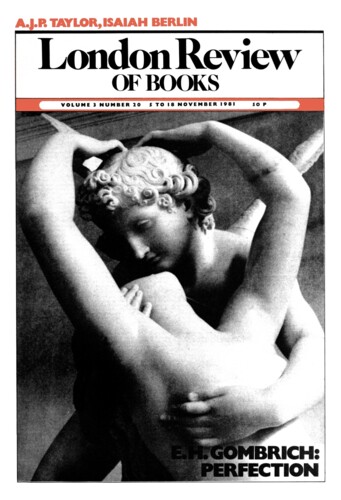E.H. Gombrich
E.H. Gombrich was until 1976 Director of the Warburg Institute and Professor of the History of the Classical Tradition in the University of London. His most recent books are The Sense of Order and Ideals and Idols.
Perfection’s Progress
E.H. Gombrich, 5 November 1981
Here, at last, is a book of which we can sincerely say in the old phrase that it meets a long-felt want. It offers, in the modest words of the Preface, ‘a series of illustrations (which are now often impossible to find except in specialised libraries) of the principal sculptures which were at one time accepted as masterpieces’ – that is, of antique statues with which, until a hundred years ago, the educated public were expected to be familiar. Of these, some of us can still visualise the Laocoon, the Apollo Belvedere or the Hercules Farnese, but would we, or would our students, be equally able to distinguish the Farnese Flora from the Capitoline Flora, or the Minerva Giustiniani from the Pallas Velletri? In future, we shall be spared any embarrassment on that score, for here is a catalogue raisonné of 95 of these once canonic works arranged in alphabetical order according to their most frequently used appellations, and providing all the relevant information about their history, their restorations, their changing fortunes in the hierarchies of taste and also the most recent archaeological opinion. The authors would never claim that their list is exhaustive: indeed they mention, but do not illustrate, a number of other works such as the Juno Ludovisi or the Clytie which occasionally rose to comparative fame. Understandably, they generally keep clear of portraits such as the Naples bust of Homer, the Vatican statues of Sophocles and Demosthenes or the Augustus of Primaporta, but, maybe, in a next edition they might include some of the works for which high claims were made by Winckelmann, such as the Minerva Albani or the Barberini Muse, which has meanwhile changed sex and is displayed in Munich as an Apollo. Even so, the invaluable repertory fills more than two hundred pages, packed with information. It is preceded by 15 equally crowded chapters admirably surveying, not only the formation and decline of the canon, but also the history of its publication in engravings, books, plastercasts and miniature copies up to the 19th century. The authors have refrained – quite rightly, of course – from chronicling the recent iconoclastic movements which resulted, not only in the removal of these casts from view, but in various gratuitous acts of vandalism: I know at least of one art school in the Middle West where, a few decades ago, they were thrown out of the window and smashed in a belated ritual of liberation.
Pieces about E.H. Gombrich in the LRB
Just How It was: The work of Henri Cartier-Bresson
Anne Hollander, 7 May 1998
Like Titian’s, Cartier-Bresson’s work began as the mirror of one epoch and is ending as that of another, simply because he invented the best mirror and kept polishing it...
Under threat
Frank Kermode, 21 June 1984
Sir Ernst Gombrich here collects various memorial lectures and memoirs of distinguished colleagues. He is a lecturer of high accomplishment – indeed I doubt if he has any serious rival in...
Canons and Conveniences
Charles Hope, 21 February 1980
Sir Ernst Gombrich is not only one of the very few historians of art now alive whose ideas have aroused wide interest outside his immediate discipline, but he is also an astonnishingly skilful...
Read anywhere with the London Review of Books app, available now from the App Store for Apple devices, Google Play for Android devices and Amazon for your Kindle Fire.
Sign up to our newsletter
For highlights from the latest issue, our archive and the blog, as well as news, events and exclusive promotions.


